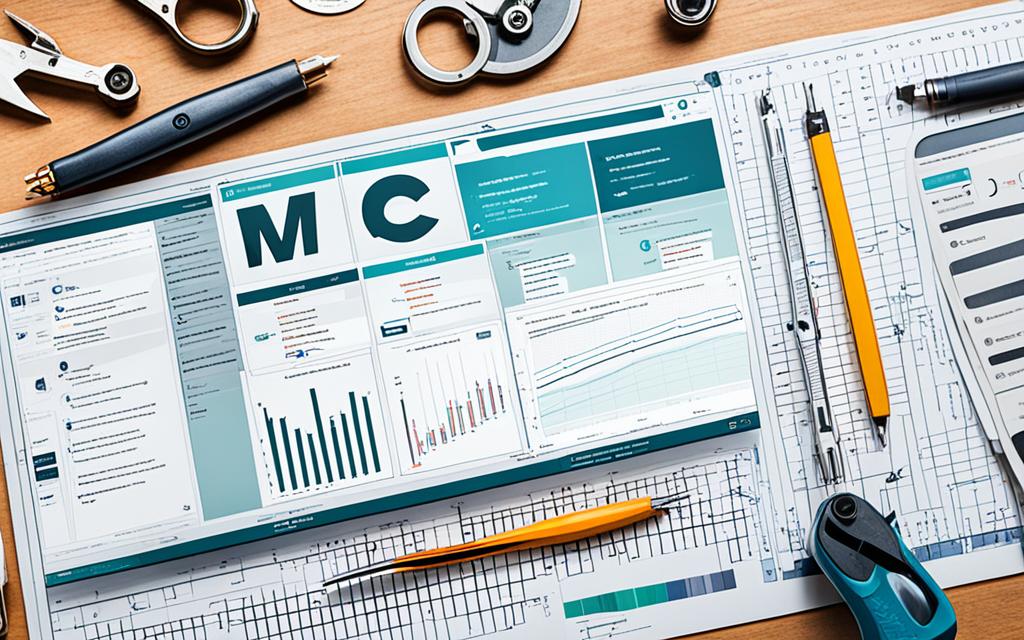Table of Contents
In today’s digital landscape, organizations are constantly seeking ways to streamline their workflow and improve efficiency. One crucial aspect of achieving this is through the use of Content Management System (CMS) design and development tools. By leveraging these tools, businesses can create a seamless digital content strategy, saving time and resources.
When it comes to streamlining workflow, CMS design and development tools play a vital role. Whether it’s designing a user-friendly interface, choosing the right CMS, or planning a content strategy, these tools offer a range of functionalities that simplify and optimize the CMS development process.
By incorporating CMS design and development tools into your digital content strategy, you can ensure a smooth and efficient workflow that meets your business objectives. This article will explore various aspects of streamlining workflow with CMS design and development tools, providing practical insights and tips to enhance your digital content strategy.
Throughout this article, we will delve into key areas such as defining clear objectives, choosing the right CMS, planning your content strategy, designing a user-friendly interface, embracing modular development, and utilizing version control. By addressing these aspects, you can optimize your CMS development process and achieve efficient results.
Stay tuned as we uncover the strategies and techniques that will help you streamline workflow, enhance efficiency, and establish a strong digital content strategy.
Define Clear Objectives
When streamlining the CMS development process, it is crucial to define clear objectives. Clear objectives provide direction, minimize confusion, and align stakeholders towards a common vision. In this section, we will discuss the steps to define clear objectives, ensuring a smooth and efficient CMS development process.
Understanding Business Goals
In order to establish clear objectives, it is important to have a deep understanding of the organization’s business goals. By aligning the CMS development process with these goals, you can ensure that the final product meets the specific needs of the business and its target audience. Taking the time to research and analyze the business objectives will lay the foundation for a successful CMS development strategy.
Using SMART Criteria
The SMART criteria help in setting clear and measurable objectives. SMART stands for Specific, Measurable, Achievable, Relevant, and Time-Bound. By applying these criteria, you can ensure that your objectives are well-defined, realistic, and can be easily tracked and evaluated. Using SMART criteria helps to maintain focus and provides a framework for goal setting in the CMS development process.
Considering Audience Needs
Another crucial step in defining clear objectives is considering the needs and preferences of your target audience. Understanding your audience’s expectations and aligning your CMS development goals accordingly will result in a more user-centric and impactful solution. By putting yourself in the shoes of your audience, you can create objectives that aim to provide an exceptional user experience and meet their specific requirements.
Maintaining Open Communication with Stakeholders
Effective communication with stakeholders is essential to ensure that objectives are defined accurately and aligned with the overall vision. Regular communication and collaboration help to gather valuable insights, address concerns, and make necessary adjustments to objectives throughout the CMS development process. By involving stakeholders in the objective-setting process, you can foster a sense of ownership and create buy-in for the final product.
By following these steps to define clear objectives, you can set a strong foundation for a streamlined CMS development process. Clear objectives provide a roadmap for the development team, promote collaboration, and ultimately ensure the successful delivery of a CMS solution that meets the organization’s goals and exceeds user expectations.
Choose the Right CMS
Selecting the appropriate CMS is essential to streamline the development process. When choosing a CMS, several factors need to be considered to ensure the right fit for your project. It’s crucial to evaluate scalability, ease of use, security measures, and customization options.
Popular CMS options such as WordPress, Joomla, and Drupal offer a range of features, but it’s vital to research and assess your specific needs before making a final decision. Each CMS has its strengths and weaknesses, and understanding how they align with your project requirements will help you make an informed choice.
To further aid your decision-making process, it’s recommended to test the CMS before committing to it. Testing will allow you to assess the platform’s intuitiveness, compatibility with your content types, and overall user experience. This step ensures that you choose the right CMS that aligns with your goals and enhances the efficiency of your project.
Considerations for Choosing the Right CMS
- Scalability: Determine whether the CMS can handle the growth of your project over time.
- Ease of use: Evaluate the CMS’s user-friendliness, as it directly impacts content creation and management.
- Security: Assess the CMS’s security features, such as regular updates and vulnerability patches, to protect your data and content.
- Customization options: Consider the level of customization the CMS provides, ensuring it meets your design and branding requirements.
Choosing the right CMS is a critical decision that can streamline your project from start to finish. By considering the factors mentioned and testing the CMS before implementation, you ensure that your chosen platform empowers your team to work efficiently, manage content effectively, and achieve your digital goals.
Plan Your Content Strategy
A well-defined content strategy plays a vital role in streamlining CMS development. By carefully planning and organizing your content, you can ensure efficient CMS development that aligns with your goals and objectives. In this section, we will discuss the key elements of an effective content strategy that contribute to efficient CMS development.
1. Audience Analysis
Understanding your target audience is the foundation of a successful content strategy. Conduct thorough research to identify their needs, preferences, and pain points. This knowledge will enable you to create content that resonates with your audience and drives engagement. Consider conducting surveys, interviews, and analyzing website analytics to gather valuable insights.
2. Content Structure
The way you structure your content influences its readability and accessibility. Plan your content structure by organizing information in a logical and intuitive manner. Use headings, subheadings, and bullet points to break down complex topics and make your content scannable. This helps users find what they need quickly and enhances their experience with your CMS.
3. Content Calendar
A content calendar is a roadmap that outlines when and what content needs to be created, published, and promoted. It helps you stay organized, maintain consistency, and meet deadlines. Create a content calendar that aligns with your business goals and consider factors such as seasonality, trends, and important events. This ensures a steady flow of content and prevents last-minute rushes.
4. Content Types
Different content types serve different purposes and engage users in unique ways. Incorporate a variety of content types in your strategy, such as articles, blog posts, videos, infographics, and case studies. This adds diversity to your CMS and caters to varied user preferences. Experiment with different formats to discover what works best for your audience.
5. Keyword Research
Keyword research is a crucial step in optimizing your content for search engines and improving discoverability. Identify relevant keywords and incorporate them strategically into your content. Use tools like Google Keyword Planner or SEMrush to find relevant keywords with high search volumes and low competition. This helps drive organic traffic to your CMS.
By implementing these strategies, you can develop a content strategy that supports efficient CMS development. Let’s continue exploring other aspects of efficient CMS development in the subsequent sections.
Design a User-Friendly Interface
When it comes to efficient CMS development, designing a user-friendly interface is of utmost importance. A user-friendly interface not only enhances the overall user experience but also improves workflow efficiency, reduces training needs, and ensures client satisfaction.
An interface that is intuitive and easy to navigate allows content creators to focus on their tasks without unnecessary complexity. By prioritizing simplicity, designers can create an interface that is visually appealing and functional, enabling users to locate and interact with key features effortlessly.
Understanding user needs is fundamental to designing a user-friendly interface. Conducting thorough research and analysis helps identify the specific requirements and preferences of your target audience. By anticipating their needs, you can tailor the interface to align with their expectations.
Usability testing is an essential step in interface design. It allows you to evaluate the effectiveness and efficiency of different design elements, identifying areas for improvement. Testing various interfaces with representative users ensures that the final interface is intuitive and easy to use.
“A user-friendly interface is like a well-designed roadmap. It guides users seamlessly through the CMS, ensuring they can easily find what they need and complete tasks efficiently.”
Emphasizing a clean and organized layout contributes to the user-friendliness of the interface. Consistent placement of navigation menus, clear labeling of buttons and links, and logical content structure all enhance the usability of the CMS.
Furthermore, incorporating responsive design principles ensures that the interface adapts seamlessly to different devices and screen sizes, enhancing the user experience across platforms.
By following these tips and best practices, you can create a user-friendly interface that optimizes the efficiency of CMS development. This not only saves time but also fosters a positive user experience, resulting in higher productivity and client satisfaction.
Embrace Modular Development
Embracing modular development is a strategic approach to enhancing the efficiency of CMS development. This method offers numerous advantages, including focused development, parallel work, reusability, and simplified maintenance. By breaking down the development process into modular components, organizations can streamline their CMS development, saving valuable time and resources.
One of the key benefits of modular development is focused development. Instead of tackling the entire CMS project at once, developers can focus on individual modules. This approach allows for greater attention to detail and ensures that each module is developed to its full potential, resulting in a higher-quality end product.
Parallel work is another advantage of modular development. With a modular approach, different teams or developers can work simultaneously on different modules. This parallel work minimizes dependencies and bottlenecks, leading to increased efficiency and faster project completion.
Reusability is a significant benefit of modular development. Once a module is developed and tested, it can be easily reused in future projects or within the same CMS. This eliminates the need to reinvent the wheel and accelerates the development process, as developers can leverage existing modules to build new functionalities.
Simplified maintenance is another advantage of embracing modular development. When changes or updates are required, developers only need to focus on the specific modules affected, rather than the entire CMS. This targeted approach to maintenance reduces the risk of introducing errors and makes the upkeep of the CMS much more manageable.
To embrace modular development effectively, several steps should be followed. Firstly, analyze the CMS to identify components that can be modularized. This analysis will help determine the scope and functionality of each module. Secondly, define the module’s scope and functionality to ensure clarity and alignment with the overall CMS objectives. Finally, implement version control to track changes, facilitate collaboration, and ensure seamless integration of different modules.
Benefits of Embracing Modular Development
- Focused development allows for greater attention to detail.
- Parallel work minimizes dependencies and accelerates project completion.
- Reusability saves time and resources in future projects.
- Simplified maintenance reduces the risk of errors.
Embracing modular development revolutionizes the CMS development process, making it more efficient and productive. By leveraging the advantages of focused development, parallel work, reusability, and simplified maintenance, organizations can streamline their CMS development and achieve optimal results. Implementing modular development is a strategic choice that empowers businesses to stay ahead in the ever-evolving digital landscape.
Conclusion
In conclusion, the use of CMS design and development tools is crucial in streamlining the workflow and achieving a seamless digital content strategy. By incorporating these tools and strategies into the CMS development process, organizations can optimize efficiency, save time, and minimize errors.
Firstly, clear objectives play a pivotal role in guiding the CMS development process. Defining objectives aligns stakeholders and ensures a focused approach. By considering business goals, using SMART criteria, and maintaining open communication, organizations can streamline their CMS development process.
Secondly, choosing the right CMS is essential for efficient workflow. Selecting a CMS that offers scalability, ease of use, security, and customization options can greatly streamline the development process. Popular CMS options like WordPress, Joomla, and Drupal provide flexibility and functionality that align with organizational needs.
Furthermore, planning a well-defined content strategy enhances efficiency in CMS development. By conducting audience analysis, creating a content structure and calendar, and performing keyword research, organizations can streamline content creation, organization, and distribution.
Additionally, designing a user-friendly interface optimizes the user experience and contributes to efficient CMS development. By understanding user needs, conducting usability testing, and prioritizing simplicity, organizations can create an interface that minimizes training needs and ensures client satisfaction.
In addition, embracing modular development provides a strategic approach to streamline the CMS development process. By breaking down the development process into smaller, manageable modules, organizations can work in parallel, promote reusability, and simplify maintenance tasks.
Finally, using version control is essential for efficient CMS development. Keeping track of changes, managing different versions, and collaborating with team members becomes seamless with effective version control.
In summary, by utilizing CMS design and development tools, organizations can streamline their workflow, improve efficiency, and achieve successful digital content strategies. Clear objectives, the right CMS selection, a well-planned content strategy, user-friendly interface design, modular development, and version control are key elements in achieving efficient results. By implementing these tools and strategies, organizations can save time, minimize errors, and ultimately succeed in their digital content endeavors.
FAQ
Why is streamlining the workflow with CMS design and development tools important?
Streamlining the workflow with CMS design and development tools is important because it helps create a seamless digital content strategy, saving time and improving efficiency.
How can clear objectives help in streamlining the CMS development process?
Clear objectives provide direction, minimize confusion, and align stakeholders, making the CMS development process more streamlined.
What factors should be considered when choosing a CMS?
Factors to consider when choosing a CMS include scalability, ease of use, security, and customization options.
Which CMS options are popular for streamlining the development process?
Popular CMS options for streamlining the development process include WordPress, Joomla, and Drupal.
What is the importance of a well-defined content strategy in CMS development?
A well-defined content strategy ensures efficient CMS development by providing a roadmap for content creation and organization.
How does designing a user-friendly interface contribute to efficient CMS development?
Designing a user-friendly interface optimizes the user experience, improves workflow efficiency, reduces training needs, and increases client satisfaction during CMS development.
What are the advantages of embracing modular development in CMS development?
Embracing modular development offers advantages such as focused development, parallel work, reusability, and simplified maintenance.













